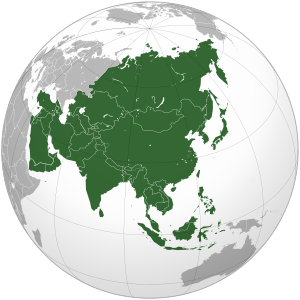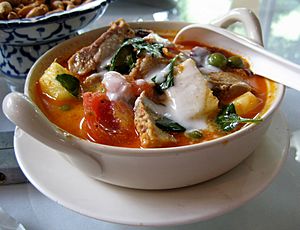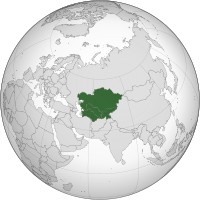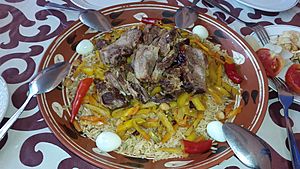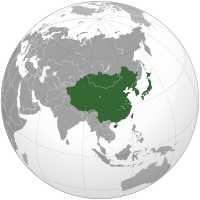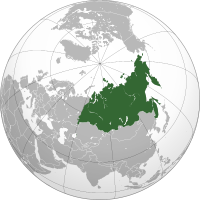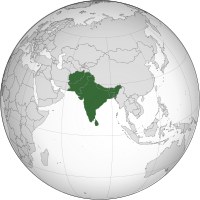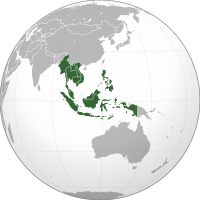Asian cuisine facts for kids
Asian cuisine means all the different cooking styles from the huge continent of Asia. Asia is the largest and most populated continent. It has many cultures, and each one has its own special food. Asian food is also called Eastern cuisine. It's known for its unique flavors, cooking methods, and spices. A super important taste in Asian cooking is "umami." This is a strong savory flavor. You can find it in fermented foods or meat extracts.
Many countries in East and Southeast Asia use similar ingredients. These include rice, ginger, garlic, sesame seeds, chili peppers, dried onions, soy sauce, and tofu. Common ways to cook are stir frying, steaming, and deep frying.
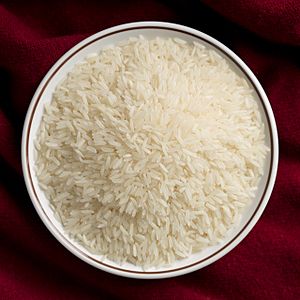
Rice is a staple food in most Asian cuisines. But different types of rice are popular in different areas. For example, glutinous rice is very important in Laos. Basmati rice is loved in the Indian subcontinent. Jasmine rice is common in Southeast Asia. Long-grain rice is popular in China, and short-grain rice is used in Japan and Korea.
Curry is a popular dish in South Asia, Southeast Asia, and East Asia. Curry dishes first came from the Indian subcontinent. Countries like Thailand often use coconut milk in their curries. Countries in West Asia usually use a yogurt base.
Contents
A Quick Look at Food History
Food is a huge part of Asian culture. Many Asian cultures love to gather family and friends for meals and celebrations. Over time, each culture in Asia developed its own unique food traditions. This happened because of their history, culture, and environment. Asian cuisine is known for being multicultural. Many specific foods are linked to different cultures.
Central Asian Food
-
Location of Central Asia.
Most Central Asian countries have similar foods. Their cooking styles share many features with their neighbors. This includes foods from West and East Asia, especially Iran and Mongolia. A dish called "plov" or "osh" is a common type of pilaf. Many of these countries use horse meat and mutton as their main meats. This is similar to beef and comes from Mongolian cuisine. In Kazakhstan and Kyrgyzstan, food traditions grew from a nomad lifestyle.
Kumis is a popular drink among Turkic peoples. It is especially common in Central Asia. Central Asia is also known as the birthplace of yogurt. Like kumis, yogurt is very popular among Turkic peoples.
East Asian Food
-
Location of East Asia.
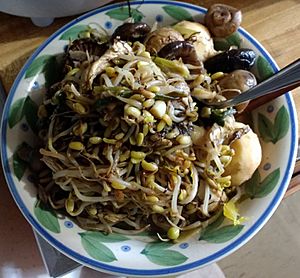
East Asian food includes dishes from China, Japan, Korea, and Mongolia. It also includes food from Hong Kong, Macau, Taiwan, and Tibet. This region has the most people in the world. So, it has many different local foods, especially in China. Common foods include rice, noodles, mung beans, and soybeans. Seafood is very popular in Japan. Mutton is a favorite in Mongolia. Bok choy (Chinese cabbage) and tea are also widely enjoyed.
North Asian Food
North Asian food is often like Russian cuisine. This is because all of North Asia is part of Russia. However, some cultures in Siberia have their own unique foods. Examples include the Yakuts (or Sakha) and Yamal cuisine. The Buryats also have their own food. It is very similar to the food of their relatives, the Mongolians.
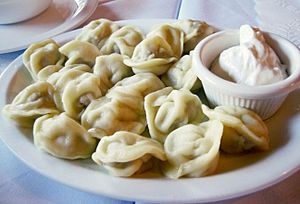

Pelmeni are small dumplings. They were first made by people in the Perm or Ugric regions. Now, they are a well-known Russian dish. Some people think they are a simpler version of Chinese wontons. In Siberia, pelmeni are frozen outdoors. This helps preserve the meat inside during the long winter. In Yamal, other drying and preserving methods are common. Key ingredients in most northern Siberian food include fish and cowberries. Yakuts, like many other Turkic-speaking people, traditionally drink kumis.
South Asian Food
-
Location of South Asia.
South Asian food comes from the Indian subcontinent. Foods in this region are usually rich in spices. It also mixes many different food cultures from around the world. Food is flavored with various types of chili, black pepper, cloves, and other herbs and spices. Using flavored butter and ghee is common in many places. Turmeric, coriander, and cumin are often used to make curries.

People often use mustard, groundnut, sunflower, and soybean oil for cooking. Using refined oil to make pooris is very popular. Poori Bhaji, Idli, Dosa, Dal Baati, and Litti Chokha are some of the most popular Indian dishes.
Vegetables are usually eaten with a type of bread called Chapati. This bread is a main food in the region. Rice is often eaten with dal (lentil soup) in the northern parts. In the southern region, it's often eaten with curd (yogurt).
Tea and coffee are popular everywhere. You can find tea at almost every street corner. Egg dishes are also widely available.
Common meats include lamb, goat, fish, and chicken. Beef is less common than in Western countries. This is because cows are special in Hinduism. Many Hindus avoid beef. Pork is not eaten by Muslims and some Hindus. Fish is often eaten in South India, Sri Lanka, and the Bengal region (Bangladesh and West Bengal). The northern region's diet mostly includes wheat and other major crops.
Southeast Asian Food
-
Location of Southeast Asia.
Southeast Asian food focuses on lightly prepared dishes. They have strong, fresh flavors from citrus and herbs. These include lime, coriander/cilantro, and basil. Ingredients in this region are different from East Asian foods. They use fish sauces instead of soy sauce. They also include ingredients like galangal, tamarind, and lemongrass. Cooking methods balance stir-frying, boiling, and steaming.
West Asian Food
-
Location of West Asia.
West Asian food is very similar to Middle Eastern food. It also includes the South Caucasus region.
West Asian cuisine is the food of different countries and people in West Asia. The food in this region is varied but also has some common features. Some common ingredients are olives and olive oil, pita bread, honey, sesame seeds, dates, sumac, chickpeas, mint, and parsley. Some popular dishes include kibbeh and shawarma.
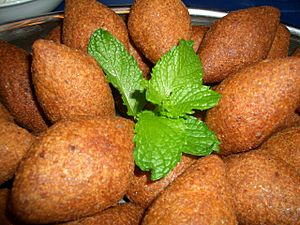

Grains are the main part of the West Asian diet, both in the past and today. Wheat and rice are the most important staple foods. Barley is also widely used. Maize (corn) has become common in some areas too. Bread is a universal staple. Everyone eats it in some form at almost every meal.
Butter and clarified butter (called Semna) are traditionally used for cooking. Olive oil is common in areas along the Mediterranean coast. Christians use it during Lent, when they avoid meat and dairy. Jewish people use it instead of animal fats to keep meat and dairy separate.
Lamb and mutton have always been the favorite meats in West Asia. Pork is not allowed in Islam and Judaism. So, it is rarely eaten in the region. Grilled meats, or kebabs, are very popular. Meat and vegetable stews are another common way to prepare meat. These are served with rice, bulgur, or bread.
Vegetables and pulses (like lentils and beans) are the main foods for most people in West Asia. They are boiled, stewed, grilled, stuffed, and cooked with meat and rice. Many types of cabbage, spinach, and chard are widely used. Root vegetables like onions, garlic, carrots, turnips, and beets are also common.
See also
 In Spanish: Gastronomía de Asia para niños
In Spanish: Gastronomía de Asia para niños


